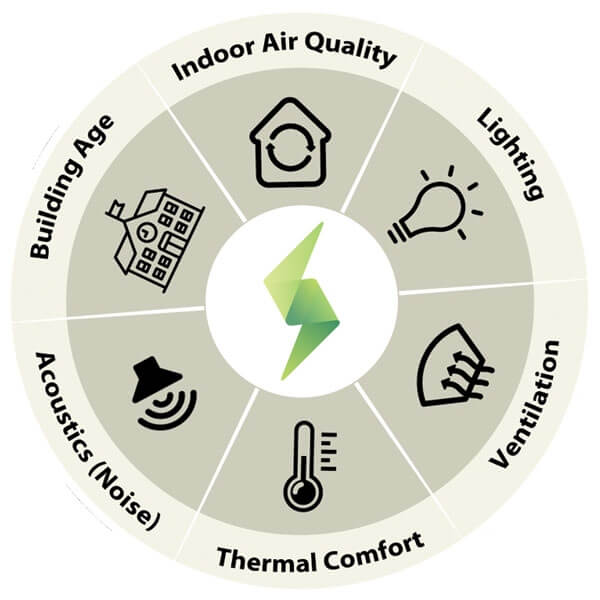Spaces Designed for Efficiency and Comfort
Poor indoor environments lead to negative consequences, such as infectious diseases, uncomfortable working conditions, and learning distractions. We are committed to designing high-performance spaces with advanced environmental controls tailored to each environment’s unique needs. Environmental performance does not have to come at the expense of increased energy consumption.
We design solutions that maximize efficiency, enhance indoor air quality, optimize lighting, and improve ventilation to create spaces that are not only energy-efficient but also comfortable. This leads to reduced operating costs, enhanced occupant satisfaction, and a lasting positive impact on your community’s sustainability.
High-Performance Buildings and Outcomes
A high-performing building is energy-efficient and meets rigorous standards for indoor air quality, lighting, and noise levels. Those standards can vary widely depending on the intended use, whether it’s a K-12 classroom, a university lab, municipal office space, a county sheriff’s station, or a courtroom. We follow guidelines and recommendations from the American Society of Heating, Refrigerating, and Air-Conditioning Engineers (ASHRAE), the EPA’s Indoor Air Quality Publications, and the Illuminating Engineering Society on all of our projects.
Our engineers are passionate about crafting solutions prioritizing the performance of every space we design. They assess air quality, ventilation, lighting, thermal comfort, acoustic performance, energy efficiency, and the building envelope and apply standards according to the end use.

Indoor Air Quality, Explained
Indoor air quality is a key indicator of a building’s overall health. Maintaining high indoor air quality is crucial to keeping occupants safe, healthy, and comfortable. Several factors influence indoor air quality, including:
- Air ventilation
- Air filtration
- Outside air exchange
- Humidity
- Temperature
- HVAC maintenance and controls
- Asthma triggers
- Radon levels
- Pests
Frequently Asked Questions
-
01
1
What are the characteristics of a high performing building?
A high performing building includes these characteristics:
- Sustainable design with a proper balance of aesthetics, accessibility, cost-effectiveness, safety, and security
- Superior indoor air quality, based on the specific requirements of the space
- Energy efficient design and performance
- Reduced greenhouse gas emissions
- Optimal lighting and acoustics
- Thermal comfort and appropriate humidity levels
-
02
2
What is four-season optimization?
The needs of students and pressures on budgets mean no school today can afford to have “that classroom” — the one where students and teachers are cold in winter and hot during the summer months. That’s why Performance Services is dedicated to four-season optimization. In every room. In every building. And in every season.
We make sure that controls systems are programmed to respond appropriately to deliver a comfortable environment at all times of the year. As such, there are four visits in the first year (one each season) from Performance Services’ experts, to make sure that all mechanical and control elements are working together effectively as specified—and in the ways owners would expect.
-
03
3
What are ENERGY STAR® and LEED certifications?
ENERGY STAR® is a performance-based certification and nationally recognized commitment to energy conservation that is given only to the top 25% of the most energy-efficient of U.S. buildings. Performance Services supports the application process and submits the application to help our clients gain the recognition and prestige their successful efforts deserve.
LEED is a design-based certification developed by the United States Green Building Council (USGBC) to encourage and accelerate good building practices and help promote sustainability for both new and existing (LEED-EB) buildings. LEED recognizes sustainable design in six key areas of human and environmental health. Performance Services employs a staff of LEED AP accredited professionals to assist owners who wish to pursue LEED certification. Nearly 50 percent of LEED points can be awarded if a building is certified as ENERGY STAR® based on the Energy and Atmosphere and Indoor Environmental Quality LEED point categories.
-
04
4
What is the key difference of an ENERGY STAR® certified building and a LEED certified building?
ENERGY STAR® is a performance-based certification that is awarded to the top 25% of the most energy-efficient U.S. buildings of its type. Achieving the ENERGY STAR® means that there is performance evidence based on energy efficiency and indoor air quality that has been certified by a professional engineer and reviewed by the Environmental Protection Agency. Performance Services has assisted building owners to achieve the ENERGY STAR® certification for more than 153 buildings. We support and submit the application to help our clients gain the recognition and prestige their successful efforts deserve.
LEED is a design-based certification developed by the United States Green Building Council (USGBC) to encourage good building practices and help promote sustainability for both new and existing (LEED-EB) buildings. LEED recognizes sustainable design in six key areas of human and environmental health. The resulting actual performance of the building is not considered or measured when a building is awarded the designation. Nearly 50% of LEED points are based on Energy Star criteria.
-
05
5
What factors are considered for laboratory environments?
There are a variety of factors that need to be considered for laboratory environments. Our team of laboratory designers and safety specialists are experts in creating safe, flexible, smart, and energy efficient spaces that can meet the needs of researchers today and into the future.
We understand that research is at the core of university life. And the best research demands the best research environments. As a result, we work with our clients to ensure that each laboratory space and clean room space:
- Assures the safety of the researchers
- Protects the integrity of the research
- Operates efficiently

